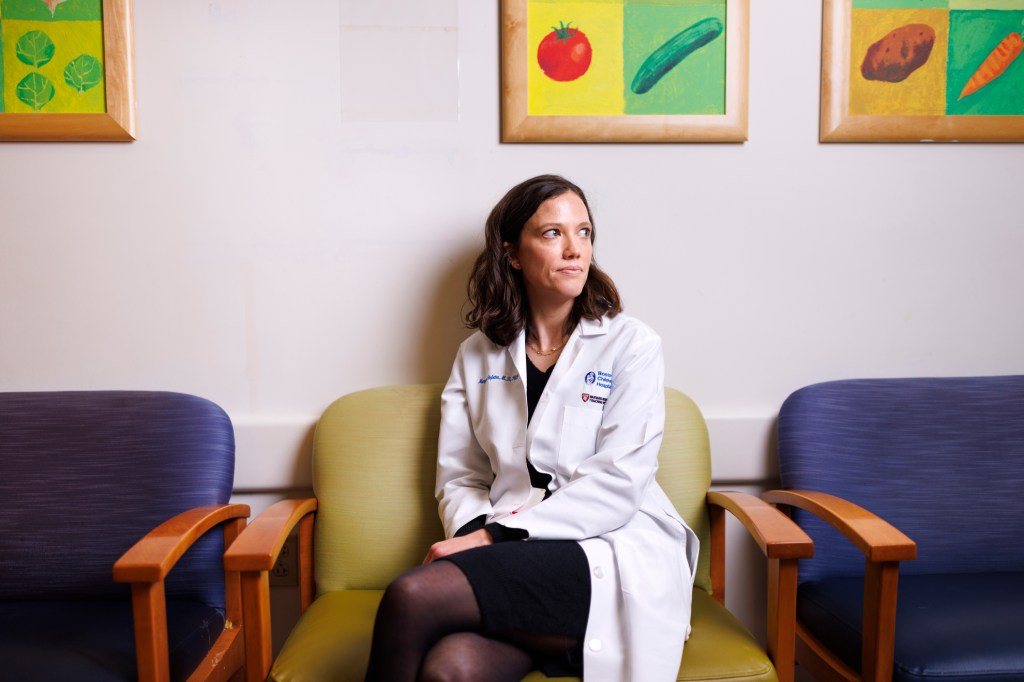Why childhood obesity endures, grows

Veasey Conway/Harvard Staff Photographer; Niles Singer/Harvard Staff Photographer
Issues are complex, touch on lifestyle, culture, genetics, economy, policy
Forty years after Steven Gortmaker first sounded the alarm, clinicians, patients and researchers are still struggling with childhood obesity. In fact, it has gotten worse over the decades.
All along, the broad outlines of the problem have been apparent: America’s kids eat more and move less than earlier generations. It has also been apparent, however, that basic formulation is misleadingly simple. The issues are complex and thorny and touch on lifestyle, culture, genetics, economy, and more.
“We’re one of the world leaders, watching obesity grow,” said Gortmaker of the situation in the U.S. The emeritus professor at the Harvard T.H. Chan School of Public Health added that the government has been reluctant to take steps that might blunt the epidemic, such as sugary beverage taxes and bans on food advertising to children. “It’s hard to make a dent in some of the drivers here.”

Steve Gortmaker.
Veasey Conway/Harvard Staff Photographer
So the problem endures, even with decades of research to guide treatment and prevention programs. Physicians are hoping that recent advances, including surgical procedures and new potent anti-obesity drugs, will help the nation gain ground — or at least stop losing it — on a major public health issue.
There is much at stake for the nation’s children and teens.
Weight problems are associated with greater risk of high blood pressure, prediabetes, Type 2 diabetes, polycystic ovary syndrome, chronic liver disease, kidney problems, cardiovascular disease, joint and movement problems, and social stigmatization.
Obesity rates among children and adolescents were around 5 percent in the 1960s. They began rising in the mid-1970s until 2020, when some 20 percent of U.S. children and adolescents — 14.7 million kids — qualified as obese.
In addition, another 16.1 percent of children and teens have a BMI in the overweight category, meaning that more than one in three U.S. children and adolescents are considered either overweight or obese.
Experts await the latest numbers, but say obesity rates spiked during the pandemic and there’s been little evidence of a decline since then.
In fact, the opposite might be true. A 2025 study shows numbers rising among youth in the two highest BMI classifications, which increased 2.5 times between 2008 and 2023.
Gortmaker is a decadeslong veteran of the battle against pediatric obesity.
In 1985, he and colleagues tied childhood obesity risk to TV watching. Every hour of television per week was associated with a 2 percent rise in obesity.
A few years later, in 1987, he and colleagues identified rising obesity among U.S. children as a serious national problem, one, they said, that the medical profession should no longer ignore.
And in 2001, Gortmaker and colleagues, including Professor of Pediatrics at Harvard Medical School and Boston Children’s Hospital David Ludwig, linked increased consumption of sugar-sweetened beverages to obesity among children.
Diet and lifestyle are undeniably important, but there are other factors.
Thinking about food and nutrition has shifted dramatically over the years. For decades, science erroneously backed low-fat diets, which promoted meals low in satiating fats but ignored the role of refined carbs like sugary beverages in promoting excess weight gain.
And, while consensus seems to have formed around the benefits of eating a diet rich in whole foods — fruits and vegetables, healthy fats, and healthy proteins — it ignores the fact that those foods and their preparation can cost more, which drives financially struggling families toward cheaper, highly processed foods that can promote weight gain.
Even that complex landscape misses the significant variation that exists between individuals, both in genetic background and in everyday life circumstances.
Disadvantaged families experience additional stress that studies have shown is associated with disordered eating behavior among children, like sneaking food and eating when not hungry.
Genetic background is also significant, and some people gain weight more easily than others. And, adding pounds can prompt physiological changes that make them harder to lose.
“For sure, many elements of our environment in modern society are contributory, but I don’t think that’s the whole picture,” said Margaret Stefater-Richards, medical director of the EMPOWER Program at Boston Children’s Hospital and an assistant professor at Harvard Medical School. “Even when weight gain is related largely to the environment, that creates a physical change that can make treating the disease much harder than just changing the environment.”

Margaret Stefater-Richards.
Veasey Conway/Harvard Staff Photographer
The battle against pediatric obesity is largely being waged on two levels: individual and societal.
Children and teens with obesity engage with specialists who today provide multidisciplinary care that acknowledges the condition’s complexity by addressing several aspects of a child’s life.
Ensuring a healthy lifestyle and nutrition are central pillars. But care can also address mental health issues and, beginning at 12 or 13, can include more intensive interventions such as bariatric surgery and GLP-1 medications, which have proven effective in reducing body weight by 10 to 20 percent.
Lauren Fiechtner, director of nutrition at Mass General Brigham for Children and HMS associate professor of pediatrics, spent 15 years developing one such program. The multidisciplinary Healthy Weight Clinic teams pediatricians, dietitians, and community health workers to guide children and their families through a yearlong treatment program addressing both lifestyle change and social determinants of health.

Lauren Fiechtner.
Niles Singer/Harvard Staff Photographer
The clinic involves 30 hours of direct contact, occurring every other week for the first six months, then monthly thereafter. Those face-to-face or telephone sessions are augmented by multiple weekly educational texts about weight control and making healthy lifestyle changes and community resources in the area. It is one of six family healthy weight programs recognized by the U.S. Centers for Disease Control and Prevention.
A randomized control trial showed it is effective at reducing BMI, binge eating, and improving quality of life. Today, Fiechtner said, it is being used in nine states, with additional expansion and training of other pediatric practices planned.
Such intensive lifestyle interventions are part of what experts describe as a layered approach to obesity in children and adolescents. While a healthy diet and increased physical activity are key elements, experts say that many patients need more support.
“Physical activity — while it has many health benefits, including weight maintenance — is actually not great for weight loss,” said Rachel Whooten, assistant professor of pediatrics at HMS and a specialist in pediatric endocrinology and obesity medicine at Mass General Brigham for Children.
For many patients, struggling with weight has been a constant for years, Whooten said. Many have experienced bullying, social ostracization, and have a negative self-image. So Whooten often doesn’t focus on a numerical weight goal but rather on improving their ability to do things they enjoy in life.

Rachel Whooten.
Niles Singer/Harvard Staff Photographer
“We have to establish what success is,” Whooten said. “We try to move away from a number on a scale and instead feel happy, healthy, well-supported, and able to do what you want to with good energy.”
Bariatric surgery is considered an effective and long-term way to reduce weight and is available for youth with severe obesity who are age 13 or older.
GLP-1 medications, two of which — Wegovy and Saxenda — have been approved for children 12 and older with severe obesity, are another powerful tool, clinicians say. Those medicines, however, may soon be harder to get, with insurers expected to reduce coverage in January for obesity alone, leaving the drugs available to those with diabetes or diabetes and obesity.
A wild card in that scenario is the deal President Trump announced in November with drug makers Eli Lilly and Novo Nordisk to reduce the cost of two popular GLP-1 drugs, Wegovy and Zepbound, as well as two obesity pills expected to soon gain regulatory approval.
New research into obesity’s genetic roots has the potential to further individualize treatment. Stefater-Richards is growing gut organoids in the lab from tissue taken during bariatric surgery in hopes of better understanding the biological processes at work and identifying new drug targets.
“We know how these medications work, but clearly GLP-1 is not the only mechanism regulating body weight,” said Stefater-Richards, who was the first author of a review article on GLP-1 medications in April in the journal Pediatrics. “There are other types of medications out there that may be developed to produce a bigger effect.”

Erica Kenney.
Veasey Conway/Harvard Staff Photographer
While clinicians and medical researchers focus on the patient, public health researchers like Gortmaker and Erica Kenney, associate professor of public health nutrition, have been focusing their efforts at a community and societal level, developing and deploying programs to prevent obesity and turn the epidemic around.
Kenney’s research focuses on improving food quality and access to disadvantaged children. She’s also looking hard at food marketing to children, particularly campaigns that target youth on social media.
Kenney has also worked with Gortmaker on the Harvard Chan School’s Childhood Obesity Intervention Cost-Effectiveness Study, CHOICES. Founded by Gortmaker, the study’s researchers focus on policy implementation, using microsimulation modeling to compare costs and outcomes of policies and programs to determine bang for the buck.
The group has created a National Action Kit, which outlines 19 different programs and policies that would reduce childhood obesity across four broad areas: at school, early childcare and out-of-school community, government, and clinical.
Some of the suggestions have already been enacted and have been shown to make a difference.
One policy change led to improved foods available in WIC, the government’s major food aid program for low-income mothers and children, leading to less juice, more whole grains, and more fruits and vegetables purchased. Enacted in 2009, Gortmaker said the changes have been shown to reduce obesity among kids.
Efforts toward a similar change to the government’s largest food program, SNAP, or the Supplemental Nutrition Assistance Program — which serves some 42 million Americans — are now just being initiated. Waivers effective in January have been granted to 12 states, allowing them to exclude certain foods, such as sugary beverages, from SNAP benefits.
Another policy in the CHOICES National Action Kit, adopted in 2018, requires calorie counts on fast food restaurant menus. CHOICES estimates that saves $22.60 in healthcare costs for every dollar invested in implementing this change.
One early and obvious target — reducing consumption of sugary beverages — has proven anything but easy. One victory removed soft drinks from schools, which CHOICES is following up with a push to ensure that water is available on school lunch lines — another cost-effective strategy to prevent excess weight gain.
Efforts to reduce sugary beverage consumption more broadly, through increased taxes, has been a tougher sell. They’ve been adopted in major municipalities, such as San Francisco, Seattle, and Philadelphia, but not at the state or national level in the U.S.
Experience shows, though, that they can be effective, with consumption declines of up to 20 percent in Seattle and Philadelphia, along with evidence for impact on weight.
Another recommendation from Gortmaker and Kenney is to improve both food and physical activity environments in all school settings — early care, primary and secondary schools, and out-of-school time — along with improved nutrition education programming, which is very limited.
A lack of such programs, Gortmaker said, leaves food industry advertising as a major influence on children’s and adolescents’ food choices.
“If children aren’t getting nutrition education in schools, they are certainly getting tons of nutrition marketing from the food industry,” Gortmaker said. “It’s driving profits for these industries.”





